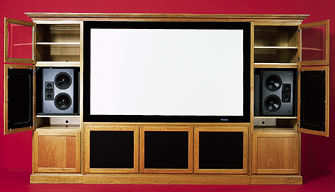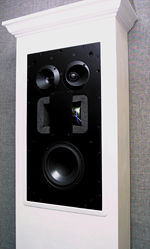THX ULTRA: Episode 2 Page 3


The only speaker placement that may not have been entirely feasible for all environments was that of the back surrounds. We put ours right next to each other, as THX recommends, about 7 feet behind the listening position and about 2 feet above seated ear level. This placement's feasibility in the average room is debatable, but the back channels are Ultra 2's hook, so I certainly recommend that you follow THX's suggested placement guidelines as much as possible to maximize the effect.
The Sound
As Ultra 2 is the central theme of this piece, I figure I'm obligated to start there. I was still determined to start my listening test with music, though, so I dusted off a couple of our Silverline samplers (with DTS and Dolby Digital tracks) and one of our well-used DTS demo discs to see what Ultra 2's MusicMode was all about. I wasn't far into Mozart's "Rondo Allegro" from Eine Kleine Nachtmusik (from the first Silverline classical sampler) before I realized that there was something to this new format. What immediately grabbed my attention was the active nature of the back surrounds, which at many points put out a sound that was almost identical to that of the front left and right channels. Some music purists may balk at this idea and immediately rattle off a list of all the reasons it's wrong. I consider myself a realist and, as such, am keenly aware of the fact that the future of music is multichannel, like it or not. Sure, it takes some getting used to, but the real essence of listening to music isn't about adhering to tradition or textbook philosophy—it's about enjoyment. I can safely say that Ultra 2, like Harman's Logic7 and some other seven-channel music schemes, is a solid step in that direction, even if it isn't by the book—at least, as we currently know it.
 Naturally, Ultra 2's stage is big and not as clearly front-loaded as it is with most current multichannel displacements. This is true surround music, in the sense that you are in the middle of its perspective. The three front speakers and sub anchor the sound, bolstered in no small part by a complementary stereo image from the back surrounds. The sides are subtle but effective in developing the sense of space and depth. Their role appears to be strictly ambient: peripheral sounds, the occasional echo, and other filler. This is well done, both by the format and by these Snell speakers. Dipoles are not known for their musical accuracy (although they do handle classical material well), and it's a good move to keep their contribution more ambient, letting the direct-radiators do the bulk of the work. The difference is easy to hear. Running these 5.1 formats straight, using only the side surrounds (although, with the Pioneer receiver, you can use only the back surrounds if you choose), the stage loses a considerable amount of its spaciousness, and there is obviously less presence from the back half of the room. As good as these particular dipoles are, they are no match for the XA1900THXs when it comes to accurate music reproduction.
Naturally, Ultra 2's stage is big and not as clearly front-loaded as it is with most current multichannel displacements. This is true surround music, in the sense that you are in the middle of its perspective. The three front speakers and sub anchor the sound, bolstered in no small part by a complementary stereo image from the back surrounds. The sides are subtle but effective in developing the sense of space and depth. Their role appears to be strictly ambient: peripheral sounds, the occasional echo, and other filler. This is well done, both by the format and by these Snell speakers. Dipoles are not known for their musical accuracy (although they do handle classical material well), and it's a good move to keep their contribution more ambient, letting the direct-radiators do the bulk of the work. The difference is easy to hear. Running these 5.1 formats straight, using only the side surrounds (although, with the Pioneer receiver, you can use only the back surrounds if you choose), the stage loses a considerable amount of its spaciousness, and there is obviously less presence from the back half of the room. As good as these particular dipoles are, they are no match for the XA1900THXs when it comes to accurate music reproduction.
 I'm also intrigued by the stereo separation that Ultra 2 culls from two speakers placed right next to one another. I switched over to the DTS sampler and Roy Orbison's "Pretty Woman" cut, where it was easier to focus on individual elements. Naturally, all of the vocals remain in front, handled predominantly by the center channel. The rears emulate just about everything else found in the front channels, though, and they do it with a degree of separation and imaging that isn't that far off, which is commendable considering their placement. This track also indicated that, while MusicMode will certainly put some things in the back that wouldn't have been there originally, it doesn't abandon the notion of the back surrounds as surrounds. Take the crowd noise at the end of this track. The clapping was faint in the center channel, a little louder in the fronts, and quite heavy in the sides and backs—smart steering. Sure, it seems like an obvious choice, but you'd be surprised how often many multichannel formats get even the basics wrong in the early going.
I'm also intrigued by the stereo separation that Ultra 2 culls from two speakers placed right next to one another. I switched over to the DTS sampler and Roy Orbison's "Pretty Woman" cut, where it was easier to focus on individual elements. Naturally, all of the vocals remain in front, handled predominantly by the center channel. The rears emulate just about everything else found in the front channels, though, and they do it with a degree of separation and imaging that isn't that far off, which is commendable considering their placement. This track also indicated that, while MusicMode will certainly put some things in the back that wouldn't have been there originally, it doesn't abandon the notion of the back surrounds as surrounds. Take the crowd noise at the end of this track. The clapping was faint in the center channel, a little louder in the fronts, and quite heavy in the sides and backs—smart steering. Sure, it seems like an obvious choice, but you'd be surprised how often many multichannel formats get even the basics wrong in the early going.
 If you've heard Surround EX, then, in some ways, you've heard what Ultra 2 does with movies. Like Surround EX, it operates with standard 5.1 formats and has even more success with the 5.1-plus formats that are starting to take hold. So, rather than focus on what Ultra 2 does with its steering, I'll look at how other Ultra 2 parameters materialize with movies. You won't have much choice but to quickly notice the prodigious bottom end that Ultra 2 subs deliver. Granted, so far I can only speak to the rumblings of the ICS Sub24; however, in order to be flat to 20 Hz and meet the new sub spec's other criteria, any Ultra 2 sub is going to have to rumble with the best of them. A healthy unit like this Snell will quickly remind you how much below-50-Hz information is present in film soundtracks—and how much you're missing with the small-driver/small-amp models that are now so common.
If you've heard Surround EX, then, in some ways, you've heard what Ultra 2 does with movies. Like Surround EX, it operates with standard 5.1 formats and has even more success with the 5.1-plus formats that are starting to take hold. So, rather than focus on what Ultra 2 does with its steering, I'll look at how other Ultra 2 parameters materialize with movies. You won't have much choice but to quickly notice the prodigious bottom end that Ultra 2 subs deliver. Granted, so far I can only speak to the rumblings of the ICS Sub24; however, in order to be flat to 20 Hz and meet the new sub spec's other criteria, any Ultra 2 sub is going to have to rumble with the best of them. A healthy unit like this Snell will quickly remind you how much below-50-Hz information is present in film soundtracks—and how much you're missing with the small-driver/small-amp models that are now so common.



















































